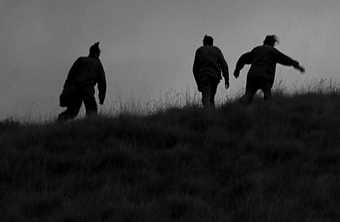 |
John Gillies, Divide |
In the wilderness of the Australian landscape with its wide open spaces and its woodland, an epic journey of 4 men across the country is taking place. Alongside them, a herd of sheep (animals outside their natural habitat). The film’s emphasis on texture renders it visually seductive. Gillies focuses on an anthill; the corrugated wool on a sheep’s flank; waves in a bubbling stream; crisp paper coasting the air; a grizzly beard. The work sounds incredible too: the pounding of hooves; sheep on ground; rushing water; crickets. It gives the film its rhythm, pulses through it. As the journey progresses, the group thins. A tree collapses, crushing one man under its weight; another rider is thrown from his horse. There is a sense almost of nature overwhelming them.
As well as being metaphors for the collective, the sheep also have obvious religious significance. At a later sheep-counting, the only lamb has disappeared. Eventually, one of the men returns holding it in his arms. He shakes his head. Is this Abraham’s sacrificial ram? This possibility is echoed in the use of biblical text. A disembodied voice reads from the Old Testament, emphasising its intractable focus on the blessed versus the cursed. Herein lies the heart of the film. The politics of exclusion fostered by the Old Testament relates to the men’s desire to conquer the land, to find their place in it. If then these men look slightly incongruous, there is the additional surprise of coming across a Chinese opera singer in the middle of the forest. His music represents another difference, a cultural tradition not associated with that landscape. The imagery changes too: now we see the delicacy of a lantern glowing in the forest; a diamante headress; a mirror. At one point, texts, both handwritten and printed, are discarded, the pages torn from a volume as a man trots through a forest of paper bark trees. Here Gillies seems to be referring to written narratives and discarding them, reminding us that the (his)stories that have been told are always inscribed with the ghosts of the ones omitted.
A sense of longing and not belonging suffuses the work. Eventually the uncultivated land is literally cracked, fissures in dry earth. At the film’s close, the sheep are running so fast across the screen that their bodies are abstracted, their movement fluid as waves. Is this Moses’ sea? I turn to face the other screen. A solitary inquisitive sheep is watching over my shoulder.
Divide, John Gillies, Dark Studio, Arnolfini, Feb 3
Marie-Anne Mancio has a doctorate in Live Art. She lectures for Tate Modern’s online contemporary art course; is an associate member of independent creative producer Jean Cameron’s arts practice; and is currently studying for an M Litt in Creative Writing at Glasgow University.
© Marie-Anne Mancio; for permission to reproduce apply to [email protected]








 back
back